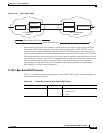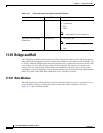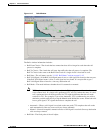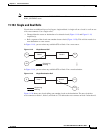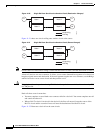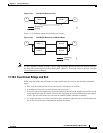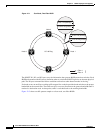
11-47
Cisco ONS 15454 Reference Manual, R8.5.x
78-18106-01
Chapter 11 Circuits and Tunnels
11.21 Reconfigured Circuits
11.21 Reconfigured Circuits
You can reconfigure multiple circuits, which is typically necessary when a large number of circuits are
in the PARTIAL status. When reconfiguring multiple circuits, the selected circuits can be any
combination of DISCOVERED, PARTIAL, DISCOVERED_TL1, or PARTIAL_TL1 circuits. You can
reconfigure tunnels, VAP circuits, VLAN-assigned circuits, VCAT circuits, CTC-created circuits, and
TL1-created circuits. The Reconfigure command maintains the names of the original cross-connects.
Use the CTC Tools > Circuits > Reconfigure Circuits menu item to reconfigure selected circuits. During
reconfiguration, CTC reassembles all connections of the selected circuits and VCAT members into
circuits based on path size, direction, and alignment. Some circuits might merge and others might split
into multiple circuits. If the resulting circuit is a valid circuit, it appears as a DISCOVERED circuit.
Otherwise, the circuit appears as a PARTIAL or PARTIAL_TL1 circuit.
Note If CTC cannot reconfigure all members in a VCAT circuit, the reconfigure operation fails for the entire
VCAT circuit and it remains in the PARTIAL or PARTIAL_TL1 status. If CTC does reconfigure all
members in a VCAT circuit, the VCAT circuit may still remain in the PARTIAL or PARTIAL_TL1
status. This occurs if the ports defined in the VCAT termination do not match the source/drop ports of
the member circuits or if one or two VCAT terminations are missing.
Note PARTIAL tunnel and PARTIAL VLAN-capable circuits do not split into multiple circuits during
reconfiguration.
11.22 VLAN Management
In Software Release 4.6 and later, VLANs are populated within topologies to limit broadcasts to each
topology rather than to the entire network. Using the Manage VLANs command in the Tools menu, you
can view a list of topology hosts and provisioned VLANs. You create VLANs during circuit creation or
with the Manage VLANs command. When creating a VLAN, you must identify the topology host (node)
where the VLAN will be provisioned. The Manage VLANs command also allows you to delete existing
VLANs.
11.23 Server Trails
A server trail is a non-DCC (logical or virtual) link across a third-party network that connects two CTC
network domains. A server trail allows A-Z circuit provisioning when no DCC is available. You can
create server trails between two distant optical or EC-1 ports. The end ports on a server trail can be
different types (for example, an OC-3 port can be linked to an OC-12 port). Server trails are not allowed
on DCC-enabled ports.
The server trail link is bidirectional and can be VT1.5, VT2, STS1, STS-3c, STS-6c, STS-12c, STS-48c,
or STS-192c; you cannot change an existing server trail to another size. It must be deleted and recreated.
A circuit provisioned over a server trail must match the type and size of the server trail it uses. For
example, an STS-3c server trail can carry only STS-3c circuits and not three STS-1 circuits.
Note There is no OSPF or any other management information exchange between NEs over a server trail.



